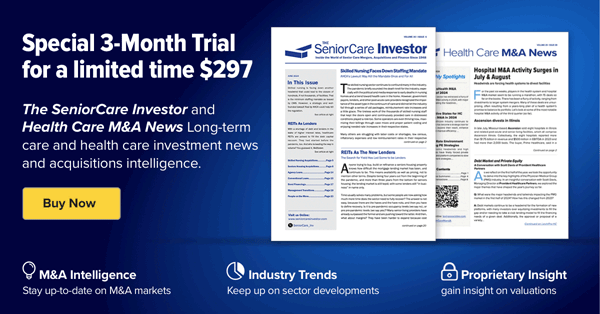Kevin Moyer didn’t hesitate when asked if there would be a reduction in 2023 regarding healthcare M&A activity due to rising interest rates.
“Absolutely,” he said. “The cost of capital is high and it will only get higher as the Fed continues to raise rates. There’s going to be an overall downfall.”
Moyer, practice lead, transaction strategy & transformation at Sax Capital Advisors, whose responsibilities include handling healthcare M&A activity, provided the forecast at the December 1st Healthcare Disruptors conference at Sax’s headquarters in Parsippany, New Jersey.
Such a development would be a reversal of recent activity. According to data captured in the LevinPro HC database, there have been 2,210 healthcare M&A deals in 2022 through December 1. This compares with 1,982 transactions between January 1, 2021, and December 1, 2021, representing a 12% increase.
The Federal Reserve last month approved a fourth consecutive three-quarter point interest rate increase in its effort to combat inflation that is near a four-decade high. The benchmark rate is at the highest level since January 2008. Borrowing costs are expected to continue rising through the start of 2023.
Private equity acquirers enjoy an advantage in the healthcare M&A space as they benefit from deep pockets and the option to pay in cash. But Moyer observed that private equity faces challenges in the healthcare M&A space.
“It is shocking to me that the dry powder is still growing, still scaling,” he said. “You have this liquidity. You have a finite supply of providers that are able to survive diligence and go to the point of acquisition.” Expanding liquidity combined with the chance that there will be a scarcity of deals could lead to bidding wars for the fewer transactions that will be completed.
Despite his prediction of deal volume reduction next year, Moyer sees opportunities for M&A activity in several healthcare specialties.
“Dental service organizations are continuing to scale and grow,” Moyer said. “There’s a lot of consolidation in the space. There’s still a lot to choose from with good operators, good providers and large books of business. With dental there’s oral surgery and there’s oral health. There’s a variety of different verticals within the vertical which makes it much more attractive to the private equity market.”
The market data prove Moyer’s observations are worth considering. M&A activity in the dental space has proven to be strong in 2022.
There have been 16 dental services organization (DSO) deals reported this year through December 1 compared with three transactions in the subsector through the first 11 months of 2021. Also, there have been 190 dental practice deals reported this year through December 1 with only 81 such transactions posted during the same period in 2021. Dental practice owners contract with DSOs to manage the administrative, marketing and/or business sides of their practice.
The significant number of physicians transitioning into retirement is providing an opportunity for increased healthcare M&A activity in numerous specialties.
“Private equity firms are acquiring firms where physicians are retiring and they are staying on for one or two years,” Moyer said. “Then they are backfilling those roles.”
Jerome Fusco, managing director, investment banking at Sax Capital Advisors, also discussed the ongoing trend of retirements impacting the healthcare M&A landscape.
“You get a lot of founders and business owners who say, ‘I’ve done this for 35 years. I’ve had enough. I don’t need to take everything off the table,’ ” Fusco said. “This will generate a lot of deal volume.
“Medical devices and medical manufacturers will be interesting. You have a lot of people running these manufacturers who are 75 or 80 years old and their children don’t want to take over the businesses.”
Doctors looking to retire have cited numerous reasons for selling their practices beyond just age. They include burnout, the loss of autonomy and health concerns.
The information contained in the LevinPro HC database proves Fusco’s point regarding Physician Medical Group (PMG) activity.
There have been 555 PMG deals reported in the first 11 months of 2022 compared with 409 PMG transactions recorded during the same period last year. There have been 108 Medical Devices transactions in 2022 through December 1 compared with 112 such deals reported between January 1, 2021, and December 1, 2021.
Other hot healthcare M&A sectors identified by Moyer included pharma companies acquiring life science companies and urgent care as well as ambulatory surgery centers and eye care practitioners “being acquired in scale.”
“Ambulatory surgery centers will continue to be hot,” Moyer said. “There hasn’t been any one firm or one collection of firms that have taken a dominant hold.”
This leaves room for further consolidation by the big players in this space, including United Surgical Partners International of Dallas, AmSurg of Nashville and Surgical Care Affiliates of Deerfield, Illinois. Ambulatory surgery centers provide services that were previously restricted to being performed only in hospitals.
There were 22 urgent care deals reported during the first of 11 months of this year compared with eight such transactions posted during the same period in 2021. And 27 ambulatory surgery center (ASC) deals were recorded this year through December 1 while there were 24 ASC transactions reported between January 1, 2021, and December 1, 2021. There have been 82 eye care deals reported during the first 11 months of 2022 as opposed to 87 such transactions recorded the same period of 2021.
Moyer also identified a disappointment in the healthcare M&A space.
“I would have thought there would have been more telehealth activity,” Moyer said. “Telehealth was as hot as it could be during COVID early on.”
There have been 52 telehealth deals in 2022 through December 1 compared with 63 telehealth transactions in the first 11 months of 2021.
Fusco identified healthcare tech as a disappointing market due to the length of time needed to be in the black and the hurdles that had to be overcome in order to show a profit. “They are less profitable generally, or the path to profitability may be greater,” Fusco said. “If you’re a lender and … you can’t lend on businesses that aren’t generating cash flow, you need to write a greater equity check. And if you have to write a greater equity check, and taking more risk that this might take longer to do it, you are going to need a greater return for your dollar, or you pay less. And if you are paying less, I might not want to sell my healthcare tech firm.”
Since healthcare tech requires less staff than service businesses, they could offer a greater return as the industry has evolved to become a higher-wage environment amid labor shortages in numerous specialties.
“There is a tremendous amount of physician groups, tremendous amounts of urgent care, tremendous amounts of companies within various healthcare niches, but that doesn’t mean they are all attractive to private equity. Nothing is absolute,” Moyer said. “You are going to have scenarios where private equity funds may start chasing opportunities to deploy that capital. They may underwrite differently or pay a higher multiple.”
Paying higher multiples for healthcare businesses could require private equity firms to re-evaluate the risk-reward formula involved in deploying capital to a part of the economy that offers the opportunity for an exceptional return on investment. The risks involved in these decisions cannot be overlooked.
Despite the numerous negative economic factors, Fusco discussed the elements supporting healthcare M&A activity.
“The resiliency of lending has been surprising because historically banks have run away from things very quickly,” Fusco said. “They haven’t just exited sectors like they have in the past. People don’t want to be seen exiting a business.
“They agree on the long-term demographics in health care. Health is something you can’t outsource. There’s a lot of things you can outsource, but I don’t want to outsource my ear, nose and throat doctor. I want to speak to a physician because I have questions to ask. That goes back to a thought of this is an industry that isn’t going anywhere and it is investible. Coming out of COVID, banks got a good amount of relief and it would be disingenuous to run now.”
Fusco added that healthcare M&A opportunities “couldn’t be more appealing for private equity” and he listed the reasons behind his statement. They included the fact that the U.S. population is aging, health care is a very local business, there is fragmentation in the market, “insurance reimbursements are big” and “there is a continued focus on core, profitable businesses.”
Macroeconomic headwinds regarding rising interest rates and inflation as well as reports earlier this year of a shrinking U.S. economy are not causing concern for Fusco. “M&A does well through recessions,” Fusco said, but he did mention that there are obviously risks associated with healthcare M&A.
“The risk with physician services is, if you’re targeting a 20% to 25% return, you are taking some risk,” Fusco said. “You don’t buy equipment. You buy people. You buy a brand.
“If you buy a practice with 20 physicians and 15 leave in the first three months, you have serious downside risk.”
Private equity firms must factor this element of risk into their investment models when considering the acquisition of a physician practice.


